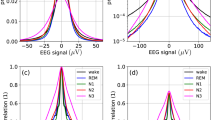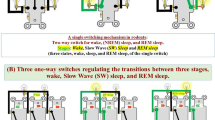Abstract
We present an open system for sleep staging, based explicitly on the criteria used in visual EEG analysis. Slow waves, theta and alpha waves, sleep spindles and K-complexes are parameterized in terms of time duration, amplitude, and frequency of each waveform by means of the matching pursuit algorithm. It allows the detection of these structures using mostly the criteria from visual EEG analysis. For example, within this framework for the first time we compute directly the relative duration of slow waves, which is a basic parameter in recognition of deep sleep stages. Performance of the system is evaluated on 20 polysomnographic recordings, scored by experienced encephalographers. Seven recordings were scored by more than one expert. Proposed system gives concordance with visual staging close to the inter-expert concordance. The algorithm is implemented in a user-friendly software system for display and analysis of polysomnographic recordings, freely available with complete source code from http://signalml.org/svarog.html.





Similar content being viewed by others
References
Anderer, P., Gruber, G., Parapatics, S., et al. (2005). An E-health solution for automatic sleep classification according to Rechtschaffen and Kales: Validation study of the Somnolyzer 24 × 7 utilizing the Siesta database. Neuropsychobiology, 51, 115–133.
Baumgart-Schmitt, R., Herrmann, W., & Eilers, R. (1998). On the use of neural network techniques to analyze sleep EEG data. third communication: Robustification of the classificator by applying an algorithm obtained from 9 different networks. Neuropsychobiology, 37, 4958.
Caffarel, J., Gibson, J. G., Harrison, J., Griffiths, C., & Drinnan, M. (2006). Comparison of manual sleep staging with automated neural network-based analysis in clinical practice. Medical and Biological Engineering and Computing, 44(1–2), 105–110.
Cohen, J. (1960). A coefficient of agreement for nominal scales. Educational and Psychological Measurement, 20, 37–46.
Dietsch, G. (1932). Fourier analyse von elektroenzephalogrammen des menschent. Pflügers Archiv für die Gesamte Physiologie, 230.
Durka, P. J. (2004). Adaptive time-frequency parametrization of epileptic EEG spikes. Physical Review E, 69(051914).
Durka, P. J. (2007a). Matching pursuit. Scholarpedia, 20910.
Durka, P. J. (2007b). Matching pursuit and unification in EEG analysis. Engineering in medicine and biology. Artech House. ISBN 978-1-58053-304-1.
Durka, P. J., Malinowska, U., Szelenberger, W., Wakarow, A., & Blinowska, K. J. (2005). High resolution parametric description of slow wave sleep. Journal of Neuroscience Methods, 147(1), 15–21.
Durka, P. J., Szelenberger, W., Blinowska, K., Androsiuk, W., & Myszka, M. (2002). Adaptive time-frequency parametrization in pharmaco EEG. Journal of Neuroscience Methods, 117, 65–71.
Hasan, J., Hirvonen, K., Varri, A., Hakkinen, V., & Loula, P. (1993). Validation of computer analysed polygraphic patterns during drowsiness and sleep onset. Electroencephalography and Clinical Neurophysiology, 87, 117–127.
Hashizume, Y., Kuwahara, H., Uchimura, N., Mukai, M., Shirakawa, S., Satomura, T., et al. (2001). Examination of accuracy of sleep stages by means of an automatic sleep analysis system, “Sleep Ukiha”. Psychiatry & Clinical Neurosciences, 55(3), 199–200.
Ibert, C., Ancoli-Israel, S., Chesson, A., & Quan, S. (2007). The AASM manual for the scoring of sleep and associated events: Rules, terminology and technical specification (1st ed.). Westchester: American Academy of Sleep Medicine.
Kim, Y., Kurachi, M., Horita, M., Matsuura, K., & Kamikawa, Y. (1992). Agreement in visual scoring of sleep stages among laboratories in Japan. Journal of Sleep Research, 1, 58–60.
Kubat, M., Pfurtscheller, G., & Flotzinger, D. (1994). AI-based approach to automatic sleep classification. Biological Cybernetics, 70(5), 443–448.
Malinowska, U., Durka, P. J., Blinowska, K., Szelenberger, W., & Wakarow, A. (2006). Micro- and macrostructure of sleep EEG. IEEE BME Magazine, 25, 26–31.
Mallat, S., & Zhang, Z. (1993). Matching pursuit with time-frequency dictionaries. IEEE Transactions on Signal Processing, 41, 3397–3415.
Martin, W., Johnson, L., Viglione, S. S., et al. (1972). Pattern recognition of EEG-EOG as a technique for all-night sleep stage scoring. Electroencephalography and Clinical Neurophysiology, 32(4):17–427.
Monroe, L. (1967). Inter-rater reliability and the role of experience in scoring EEG sleep. Psychophysiol, 5, 376–384.
Park, H.-J., Oh, J.-S., Jeong, D.-U., & Park, K.-S. (2000). Automated sleep stage scoring using hybrid rule- and case-based reasoning. Computers and Biomedical Research, 33, 330–349.
Penzel, T., Hirshkowitz, H., Harsh, J., Chervin, R., Butkov, N., Kryger, M., et al. (2007). Digital analysis and technical specifications. Journal of Clinical Sleep Medicine, 3(2), 109–120.
Pittman, S., MacDonald, M., RB, R. F., Malhotra, A., Todros, K., Levy, B., et al. (2004). Assessment of automated scoring of polysomnographic recordings in a population with suspected sleep-disordered breathing. Sleep, 27(7), 1394–1440.
Prinz, P., Larsen, L., Moe, K., Dulberg, E., & Vitiello, M. (1994). C stage, automated sleep scoring: Development and comparison with human sleep scoring for healthy older men and women. Sleep, 17(8), 717–7.
Ray, S., Lee, W., Morgan, C. D., & Airth-Kindree, W. (1986). Computer sleep stage scoring—an expert system approach. International Journal of Bio-medical Computing, 19(1), 43–61.
Rechtschaffen, A., & Kales, A., Eds. (1968). A manual of standardized terminology, techniques and scoring system for sleep stages in human subjects. Number 204 in National Institutes of Health Publications. Washington DC: US Government Printing Office.
Schaltenbrand, N., Lengelle, R., Toussaint, M., Luthringer, R., Carelli, G., Jacqmin, A., et al. (1996). Sleep stage scoring using the neural network model: Comparison between visual and automatic analysis in normal subjects and patients. Sleep, 9(1), 26–35.
Smith, J., & Karacan, I. (1971). EEG sleep stage scoring by an automatic hybrid system. Electroencephalography and Clinical Neurophysiology, 31(3), 231–237.
Stanus, E., Lacroix, B., Kerkhofs, M., & Mendlewicz, J. (1987). Automated sleep scoring: a comparative reliability study of two algorithms. Electroencephalography and Clinical Neurophysiology, 66(4), 448–456.
Virkkala, J., Hasan, J., Värri, A., Himanen, S.-L., & Müller, K. (2007). Automatic sleep stage classification using two-channel electro-oculography. Journal of Neuroscience Methods, 166, 109–115.
Żygierewicz, J., Blinowska, K. J., Durka, P. J., Szelenberger, W., Niemcewicz, S., & Androsiuk, W. (1999). High resolution study of sleep spindles. Clinical Neurophysiology, 110(12), 2136–2147.
Acknowledgements
This work was supported by Polish funds for science 2006-2009, grant 3T11E02330 and NN518262933.
Author information
Authors and Affiliations
Corresponding author
Rights and permissions
About this article
Cite this article
Malinowska, U., Klekowicz, H., Wakarow, A. et al. Fully Parametric Sleep Staging Compatible with the Classical Criteria. Neuroinform 7, 245–253 (2009). https://doi.org/10.1007/s12021-009-9059-9
Published:
Issue Date:
DOI: https://doi.org/10.1007/s12021-009-9059-9




